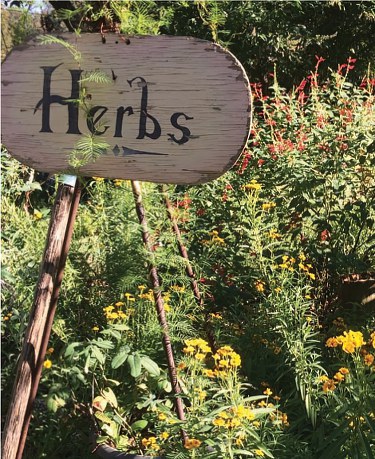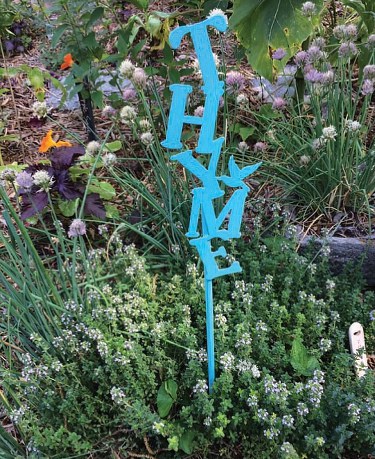Herbs are wonderful plants that add flavor to almost any dish.
Growing your own will contribute to the joy of gardening and cooking while controlling the quality and nutrition value of the foods you serve. A few basics for growing herbs are good garden soil, not overly rich but not poor, a minimum of 5 – 6 hours of sun per day, preferably morning sun and adequate water. Most herbs are drought tolerant but may require supplemental watering to get established and during dry times. An important requirement is good drainage.
Harvesting a few sprigs for a salad or to toss in the stew pot should be done when you are ready to prepare the dish. If you plan to harvest a large quantity for future use the best time to gather is in the morning after the dew has dried. When harvesting leaves cut the stem then remove the leaves. You can cut as much as one half to three-quarters of the current year’s growth. Frequent harvesting is preferred (about every 30 – 60 days) rather than severe pruning.
“Drying herbs on a screen in a well-ventilated room out of direct sunlight works well for small quantities. To air-dry, tie bunches tightly with string or rubber bands, hang in a dark, well ventilated area for about two weeks, or until crispy dry. Remove stems, place herbs in dark glass bottles or containers and store in a cool dry place.”


FOLLOWING ARE SEVERAL POPULAR CULINARY HERBS THAT GROW AND THRIVE IN THIS AREA, ARE ATTRACTIVE IN THE LANDSCAPE AND ENHANCE THE FLAVOR OF FOOD IN THE KITCHEN.
BASIL (Ocimum Basilicum) an annual growing 12” – 36” has a sweet clove flavor and fragrance. Wonderful with tomatoes, both fresh and cooked, a must in pesto, sprinkle on pasta, fish, chicken and salads. Cook only briefly or cut and add at end of cooking. Basil will thrive in the heat of a Texas summer in addition to adding color to the landscape. Sweet Basil is the favored variety but Cinnamon, Thai, Opal, Genovese, Purple Ruffles, and many others will add texture and color to the garden as well as interest to food. Basil is a heat loving plant so plant after the soil is above 65 degrees.
CHIVES, onion (Allium schoenoprasum) a perennial that grows in small clumps with hollow green leaves with a delicate onion flavor. Add chopped leaves to soups and salads; use in cottage cheese, cream cheese, omelets and baked potatoes. Pretty purple flowers add zing to green salads. Plant in early spring in full sun or part shade. Chives are a companion plant for roses and tomatoes as a deterrent to black spot and mildew. There is also a garlic flavored variety.
MEXICAN MINT MARIGOLD (Tagetes lucita) is a tender perennial, Texas native and a wonderful substitute for French tarragon which does not like the southern climate. The flavor is sweet and somewhat like anise. Sow seed after danger of frost has passed. Its yellow flower adds color to the fall landscape and is one of the last herbs to flower in the fall garden.
OREGANO (Origanum spp.) is a hardy perennial and can spread to a three-foot shrub. Oregano has a sharp aromatic flavor. Known as the pizza herb, it is found in most Mexican, Greek and Italian dishes. It adds a warm spice flavor to tomato sauces. Plant will stay green during mild Texas winters. Use fresh or dried and allow herb to slow cook in the pot.
Mexican oregano Lippia graveolens, is a member of the verbena family and is the preferred oregano in Mexican cooking. Both varieties flourish in North Texas.
PARSLEY (Petroselinum crispum and p. neapolitanum) is a biennial. Considered a breath freshener, parsley contains significant amounts of vitamins A, B and C. Add to salads, egg dishes, cream sauces, gravies, stews and soups. Seeds are slow to germinate so it is best to start from container plants. Plant will remain green through mild winters but is best treated as an annual. The curly (crispum) makes an attractive border around the garden. The flat leafed (Italian) parsley has a more pronounced flavor and is preferred by professional chefs.
ROSEMARY (Rosmarinus officinalis) is a tender perennial in north Texas. Prostrate or creeping stays smaller than the large upright variety. Rosemary’s pungent pine flavor is especially good with foods high in fat such as lamb and pork. Add to rice and potatoes, also good in breads and stuffing. Rosemary thrives in the Texas heat. Plant in full sun and give it plenty of room as it will become a very large evergreen bush. Rosemary is being used more and more in the home landscape as a hedge. The prostrate or creeping variety will trail down a wall or garden edge. Both have pretty blue to pink flowers beginning in late summer through winter.
SAGE (Salvia officinalis) is a perennial that spreads to a 3-foot shrub. This culinary salvia has a strong musky flavor that helps balance rich foods. Combine with thyme, marjoram or savory in pork, poultry and fatty fish. A pinch of sage improves the flavor of soups, tomato dishes, cream sauces and gravies. It is a traditional seasoning for Thanksgiving turkey and stuffing. Plant in full sun in well-drained soil. Sage has a gray-green colored leaf but also comes in purple, golden and variegated colors.
THYME (Thymus spp.) is a perennial that comes in creeping to small shrub size. Thyme is generally combined with other herbs and added to soups, salads, stuffing, sausage, clam chowder, bouquet garni, pork or lamb. It can flavor vinegar, marinades and oils. Lemon varieties are used in jelly and desserts. It is one of the fines herbes of French cuisine. Grow from seeds or seedlings. Plant around walkways as the oils release a pleasant scent when walked on. Thyme reportedly benefits eggplant, potatoes, and tomatoes when planted near them. In addition, gardeners recommend plantings of thyme to repel cabbage worms and whiteflies.
To learn more about growing herbs in our area visit the Ellis County Master Gardeners’ Horticulture Learning Garden in Getzendaner Park where we have a test garden of edibles including herbs, tomatoes, peppers and other vegetables. It is always open to the public and a great place to see varieties recommended for our area.







